12.1 An Introduction to Psychological Disorders
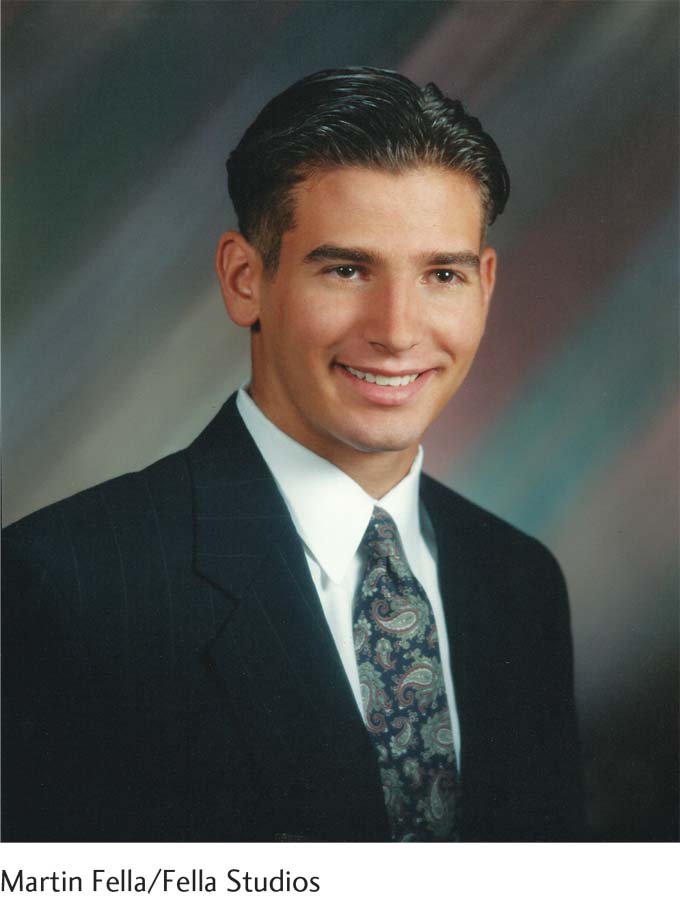
Ross Szabo appears happy in his senior class photo, but beneath his smile is profound pain and suffering. This was the year Ross began to have persistent thoughts of death and suicide that nearly drove him to take his own life.
WINTER NIGHT It was a clear, cold night in January when 17-
For the 4 months leading to that moment, Ross had been free-
Some people say suicide is a selfish act; a person ends his own suffering and destroys the lives of those left behind. Ross truly believed his friends and family would be happier without him. Maybe you’re the problem; maybe you’d be doing them a favor by removing the problem, Ross remembers thinking to himself. “I didn’t think I would have a funeral,” he says. “I didn’t think anyone should care about me.”
When Ross got home, he tried calling a friend but was too upset to speak. So he walked into the bathroom and prepared to kill himself. Fortunately, his father was home and could tell Ross was in distress. He convinced his son to come downstairs and talk. “If you don’t take me to the hospital right now, I’m going to kill myself,” Ross said as he walked into the kitchen. Instead of returning to school the next day, Ross was admitted to the hospital. 
Note: Ross Szabo’s story is based on personal communications with Ross Szabo and various passages from the book he coauthored with Melanie Hall: Behind Happy Faces (Szabo & Hall, 2007). Unless otherwise specified, quotations attributed to Ross Szabo and Melissa Hopely are personal communications.
LEARNING OBJECTIVES After reading and studying this chapter, you should be able to:
LEARNING OBJECTIVES After reading and studying this chapter, you should be able to:
LO 1 Define psychological disorders and the criteria used to identify abnormal behavior.
LO 2 Recognize limitations in the classification of psychological disorders.
LO 3 Summarize the etiology of psychological disorders.
LO 4 Define anxiety disorders and demonstrate an understanding of their causes.
LO 5 Summarize the symptoms and causes of obsessive-
LO 6 Summarize the symptoms and causes of major depressive disorder.
LO 7 Compare and contrast bipolar disorders and major depressive disorder.
LO 8 Recognize the symptoms of schizophrenia.
LO 9 Analyze the biopsychosocial factors that contribute to schizophrenia.
LO 10 Differentiate between antisocial and borderline personality disorders.
LO 11 Identify differences among dissociative disorders.
What’s Normal, What’s Not
Synonyms
psychological disorder mental disorder, mental illness, psychiatric illness, mental disability, mental disease
LO 1 Define psychological disorders and the criteria used to identify abnormal behavior.
bipolar disorder A psychological disorder marked by dramatic swings in mood, ranging from manic episodes to depressive episodes.
A year-
psychological disorder A set of behavioral, emotional, and/or cognitive symptoms that are significantly distressing or disabling in terms of social functioning, work endeavors, and other aspects of life.
Synonyms
abnormal psychology experimental psychopathology, clinical psychology
A psychological disorder is a set of behavioral, emotional, and cognitive symptoms that are significantly distressing and disabling in terms of social functioning, work endeavors, and other aspects of life. These symptoms are not the result of religious or spiritual experiences; nor are they mere departures from cultural norms. And although stressors can trigger symptoms of psychological disorders, these conditions primarily result from disturbances in psychological, biological, and developmental processes (American Psychiatric Association, 2013).
CONNECTIONS
The field of abnormal psychology encompasses the study of psychological disorders as well as their treatment. In Chapter 1, we described various mental health professions, and the training they require. The current chapter focuses on abnormal psychology, a subfield many people associate with the word psychology.
The behaviors and symptoms associated with psychological disorders are not typical in the general population; in other words, they are abnormal. The academic field devoted to the study of psychological disorders is generally referred to as abnormal psychology. Researchers and scholars in abnormal psychology typically have backgrounds in clinical psychology, or psychiatry if they obtained medical degrees.
DEFINING ABNORMAL BEHAVIOR Psychologists and other mental health professionals determine if a behavior is abnormal using a variety of criteria (Table 12.1). Perhaps the most straightforward criterion is typicality (or lack thereof). An atypical behavior is one that is rarely seen, or infrequent. The profound sadness Ross experienced is relatively rare. Most people experience sadness, even deep sadness at times, but suicidal thoughts are unusual. Although the typicality criterion is useful, it is not enough to confirm the existence of a psychological disorder. A child prodigy who learns to play the piano like a virtuoso by the age of 5 is atypical, but his rare talent does not indicate a psychological disorder.
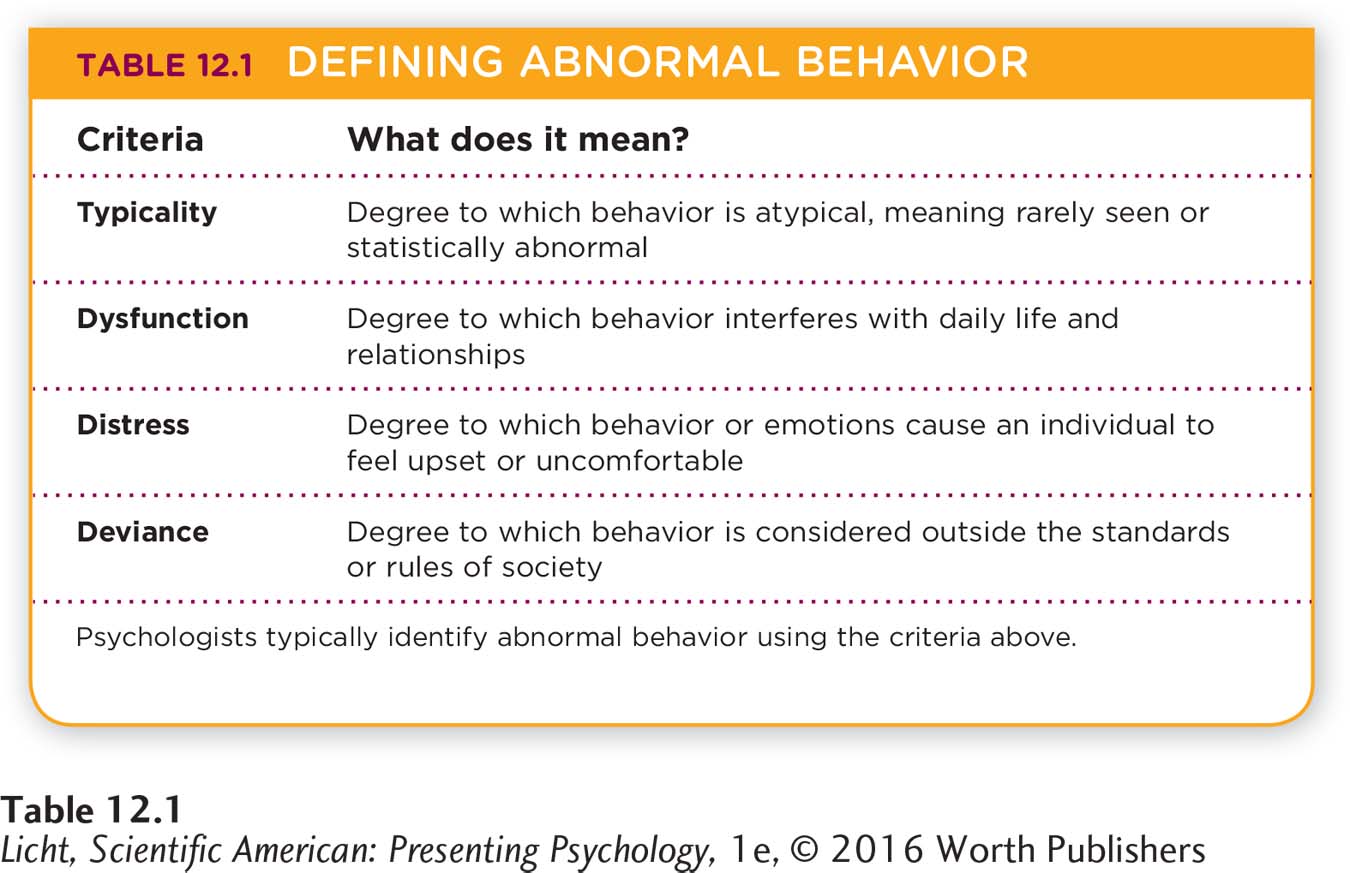
maladaptive behaviors Behaviors or actions that run counter to what is in one’s own best interest.
We should also consider maladaptive behaviors, or actions that run counter to one’s best interests. The degree of risk associated with these maladaptive behaviors (both to oneself and others) is often used by professionals to determine if a person needs to be admitted to a hospital. In Chapter 13, you can see how Dr. Dan Foster used this criterion in deciding whether to seek hospital care for a client with schizophrenia. We should point out, however, that maladaptive behavior is not always a sign of abnormality. People without disorders may exhibit maladaptive behaviors; just think of a child who has tantrums from time to time, or an adult who drowns his sorrows in alcohol one night.
abnormal behavior Behavior that is atypical, dysfunctional, distressful, and/or deviant.
To arrive at a more definitive determination of abnormal behavior, mental health professionals typically rely on three criteria (in addition to typicality): dysfunction, distress, and deviance, or the “3 Ds” (American Psychiatric Association, 2013; Wakefield, 1992).
The first D, dysfunction, indicates the degree to which a behavior interferes with daily life and relationships. Ross’ depression sometimes rendered him unable to get out of bed; this type of behavior certainly has the potential to interfere with daily life. But dysfunction alone does not confirm the presence of a psychological disorder. If you stay up all night to meet a deadline, you might experience temporary dysfunction in memory and attention, but that doesn’t mean you have a disorder.
The second D is personal distress. Feeling regularly upset or uncomfortable because of unwanted behaviors or emotions is another feature of abnormality, and it’s not always evident from the outside. Prior to his suicide attempt, Ross appeared to be happy and healthy, but inside he was suffering. There are times, however, when distress does not accompany a disorder. When Ross experienced the euphoric highs of bipolar disorder, he may not have been distressed at all. People with psychological disorders do not always have the insight to recognize that a problem exists.

Occupy Wall Street protesters camp out in Lower Manhattan’s Zuccotti Park in the autumn of 2011. Setting up a tent and sleeping in a city park are behaviors that challenge social norms—
The third D is deviance, or the degree to which a behavior is considered to be outside the standards or rules of a society. Behaving in a way that does not conform to social expectations might be indicative of a psychological disorder. Individuals who are euphoric might talk too loudly in a library or church where people are expected to be quiet, or become so disinhibited that they walk around naked in a public place. Yet, the presence of deviance alone does not necessarily indicate a psychological disorder. Political protesters, for example, may deliberately break social norms to make a statement. Many participants in Occupy Wall Street chose to set up camp and sleep in public places normally used by others just passing through. Their behavior was deviant but not necessarily suggestive of a psychological disorder.
We should note that conceptions of abnormality and definitions of psychological disorders have changed during the course of history. Homosexuality was once considered a psychological disorder, but this notion was overturned in the 1970s and 1980s by psychiatrists and other mental health professionals (Silverstein, 2009), in part because cultural norms had changed. Always remember that the definition or meaning of “abnormal” is relative to place and time.
IT’S A CONTINUUM It’s important to understand that anyone can have experiences that resemble symptoms of psychological disorders. This is because there is a continuum for many behaviors and feelings: Those at one end are generally considered normal, and those at the other end abnormal. Ross’ profound sadness would likely fall at the abnormal end of the continuum, whereas a teary farewell to a close friend who is moving away would be at the normal end.
CULTURALLY DEFINED The definition of mental health is not the same for all groups of people. As the biopsychosocial model reminds us, we must consider culture and other social influences when trying to understand concepts like “normal” and “abnormal.” Some disorders and symptoms are unique to particular cultures. Koro, for example, is an episode of intense anxiety observed mainly in Southeast Asia, although similar conditions have been documented in China. The main feature of koro is the unrealistic and intense fear that sexual organs will be pulled into the body, perhaps resulting in death (American Psychiatric Association, 2013; Roy et al., 2011). A man with koro might be exceedingly anxious about the idea of his penis disappearing into his abdomen, whereas a woman might fear that her nipples will be pulled into her chest. Another example is susto, most evident in Latino populations (Donlan & Lee, 2010). Someone with susto reacts to a frightening situation with the belief that her soul has left her body, which ultimately results in illness and sadness (American Psychiatric Association, 2013). Unlike susto and koro, schizophrenia (discussed later in the chapter) is evident across all cultures and throughout the world, suggesting it is universal.
Let’s review what we have learned. Psychologists use three main criteria (in addition to typicality) to identify abnormality—
THINK again
The Insanity Plea
insanity A legal determination of the degree to which a person is responsible for criminal behaviors.
CONNECTIONS
In Chapter 7, we discussed the availability heuristic; we often predict the probability of something happening in the future based on how easily we can recall a similar type of event from the past. Here, the vividness of a crime and the ensuing trial make the insanity plea more available in our memories, so we are prone to overestimate its likelihood in the future.
 Perhaps you have heard the term “insanity” used in a legal context. “The defendant got off on an insanity plea,” or “The defense failed to demonstrate insanity.” What do these statements mean? Insanity is a legal determination of the degree to which a person is responsible for his criminal behaviors. Those deemed legally insane are thought to have little or no control over or understanding of their behaviors at the time they committed their crimes. Therefore, they are offered psychological treatment rather than criminal punishment such as imprisonment or the death penalty. In America, 46 states offer a form of the insanity defense; only Idaho, Kansas, Montana, and Utah do not (Lilienfeld & Arkowitz, 2011, January/February). Many people believe that the insanity defense is frequently used, but it’s invoked in only about 1% of cases. Of those cases, just 10–
Perhaps you have heard the term “insanity” used in a legal context. “The defendant got off on an insanity plea,” or “The defense failed to demonstrate insanity.” What do these statements mean? Insanity is a legal determination of the degree to which a person is responsible for his criminal behaviors. Those deemed legally insane are thought to have little or no control over or understanding of their behaviors at the time they committed their crimes. Therefore, they are offered psychological treatment rather than criminal punishment such as imprisonment or the death penalty. In America, 46 states offer a form of the insanity defense; only Idaho, Kansas, Montana, and Utah do not (Lilienfeld & Arkowitz, 2011, January/February). Many people believe that the insanity defense is frequently used, but it’s invoked in only about 1% of cases. Of those cases, just 10–
THE INSANITY PLEA DID NOT WORK SO WELL FOR SERIAL MURDERER JEFFREY DAHMER.

In the summer of 2012, James Holmes walked into a movie theater in Aurora, Colorado, and opened fire on the audience, killing 12 people. Holmes’ attorneys entered a plea of insanity; they claim he committed the murders while in a psychotic state (Ingold, 2013, September 30). Refusing to accept the insanity plea, jurors determined he should spend the rest of his life in prison (Associated Press, 2015, August 26).
Now that we have explored the meaning of abnormality, let’s find out more about the experience of having a psychological disorder—
 DISPELLING STIGMA: ROSS FINDS HIS VOICE After being discharged from the hospital, Ross returned to school where he was greeted with rumors and stares. A couple of his friends stopped spending time with him, perhaps because they were afraid of what they didn’t understand. Or maybe it was because people in the farmlands of Pennsylvania didn’t talk much about emotions and mental health.
DISPELLING STIGMA: ROSS FINDS HIS VOICE After being discharged from the hospital, Ross returned to school where he was greeted with rumors and stares. A couple of his friends stopped spending time with him, perhaps because they were afraid of what they didn’t understand. Or maybe it was because people in the farmlands of Pennsylvania didn’t talk much about emotions and mental health.
Not long after the hospital stay, a psychologist came to Ross’ school to give his annual presentation about helping people with psychological disorders. Most of the students thought the topic was funny and laughed (perhaps out of discomfort) throughout the presentation. But Ross did not find it one bit amusing. After class, he told his teacher that he wanted to give his own presentation. Before long, Ross was standing before his peers, heart pounding and knees wobbling, talking about life with bipolar disorder. The students listened intently, and some approached Ross after class to talk about their own struggles with psychological disorders. By coming forward to share his experiences, Ross dispelled some of his classmates’ misconceptions and fears about psychological disorders. He was a real person they knew and liked, and he had a disorder. 
stigma A negative attitude or opinion about a group of people based on certain traits or characteristics.

The late Heath Ledger plays the “Joker” in The Dark Knight (2008). Movie characters like the Joker, whom Ledger described as a “psychopathic, mass-
WHAT IS STIGMA? Watching his classmates laugh about people with psychological disorders, Ross bore witness to the stigma attached to mental illness. Stigma is a negative attitude or opinion about groups of individuals based on certain traits or characteristics they have. It can lead to discrimination and stereotypes, and negative characterizations in general (Corrigan, 2005). Surely, you have heard people equate psychological disorders with violence and aggression, or perhaps you have seen TV shows portraying people with mental illness as wild and aggressive. Reality check: People with psychological disorders are usually not violent. Other factors, such as lower socioeconomic status, male gender, and substance abuse, may be better predictors of violence (Stuart, 2003). The criterion of being a danger to oneself or others does determine the necessity of treatment, but given the degree of violence in our society, violent behavior is actually atypical of people with serious psychological disorders, and more commonly associated with substance abuse (Arkowitz & Lilienfeld, 2011, July/August; Fazel, Gulati, Linsell, Geddes, & Grann, 2009).
Stigma can have devastating repercussions. It may lower self-
What can we do to combat stigma? One suggestion is to use “people-
Classifying and Explaining Psychological Disorders
How was Ross diagnosed with bipolar disorder? He consulted with a psychiatrist. But how did this mental health professional come to the conclusion that Ross suffered from bipolar disorder, and not something else? Given what we know about the complexity of determining abnormal behavior, it probably comes as no surprise that clinicians have not always agreed on what qualifies as a psychological disorder. Over the years, however, they have developed common criteria and procedures for making reliable diagnoses. These criteria and decision-
THE DIAGNOSTIC AND STATISTICAL MANUAL OF MENTAL DISORDERS Think about the last time you were ill and went to a doctor. You probably answered a series of questions about your symptoms. The nurse took your blood pressure and temperature, and the doctor performed a physical exam. Based on these subjective and objective findings, the doctor formulated a diagnosis. Mental health professionals must do the same—
When the DSM was comprehensively revised in 1994 (for DSM-
INFOGRAPHIC 12.1
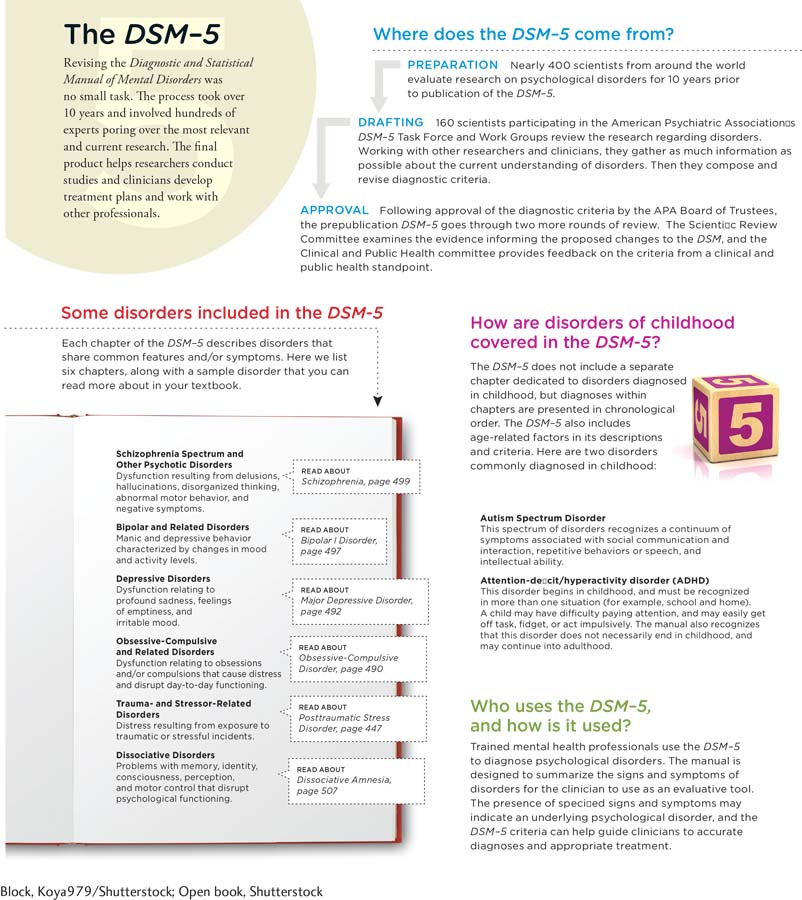
LO 2 Recognize limitations in the classification of psychological disorders.
CRITICISMS OF CLASSIFICATION Why is the DSM important? Classifying mental disorders helps therapists develop treatment plans, enables clients to obtain reimbursement from their insurance companies, and facilitates research and communication among professions. But there is a downside to classification. Anytime someone is diagnosed with a mental disorder, he runs the risk of being labeled, which can lead to the formation of expectations—
didn’t SEE that coming
“On Being Sane in Insane Places”
 What do you think would happen if you secretly planted eight completely “sane” people (no history of psychological disorders) in American psychiatric hospitals? The hospital employees would immediately identify them as “normal” and send them home . . . right?
What do you think would happen if you secretly planted eight completely “sane” people (no history of psychological disorders) in American psychiatric hospitals? The hospital employees would immediately identify them as “normal” and send them home . . . right?
NO HOSPITAL STAFF MEMBER IDENTIFIED THE PSEUDOPATIENTS AS FRAUDS.
In the early 1970s, psychologist David Rosenhan and seven other mentally healthy people managed to get themselves admitted to various psychiatric hospitals by faking auditory hallucinations (“I am hearing voices”), a common symptom of schizophrenia. (Such a feat would be close to impossible in this day and age, where people with documented psychological disorders struggle to obtain inpatient treatment at all; Scribner, 2001.) Upon admission, each of these pretend patients, or “pseudopatients,” immediately stopped putting on an act and began behaving like their normal selves. But within the walls of a psychiatric hospital, their ordinary behavior assumed a whole new meaning. Staff members who spotted the pseudopatients taking notes concluded it must be a symptom of their psychological disorder. “Patient engaged in writing behavior,” nurses wrote of one pseudopatient. “Nervous, Mr. X?” a nurse asked a pseudopatient who had been walking the halls out of sheer boredom (Rosenhan, 1973, p. 253).
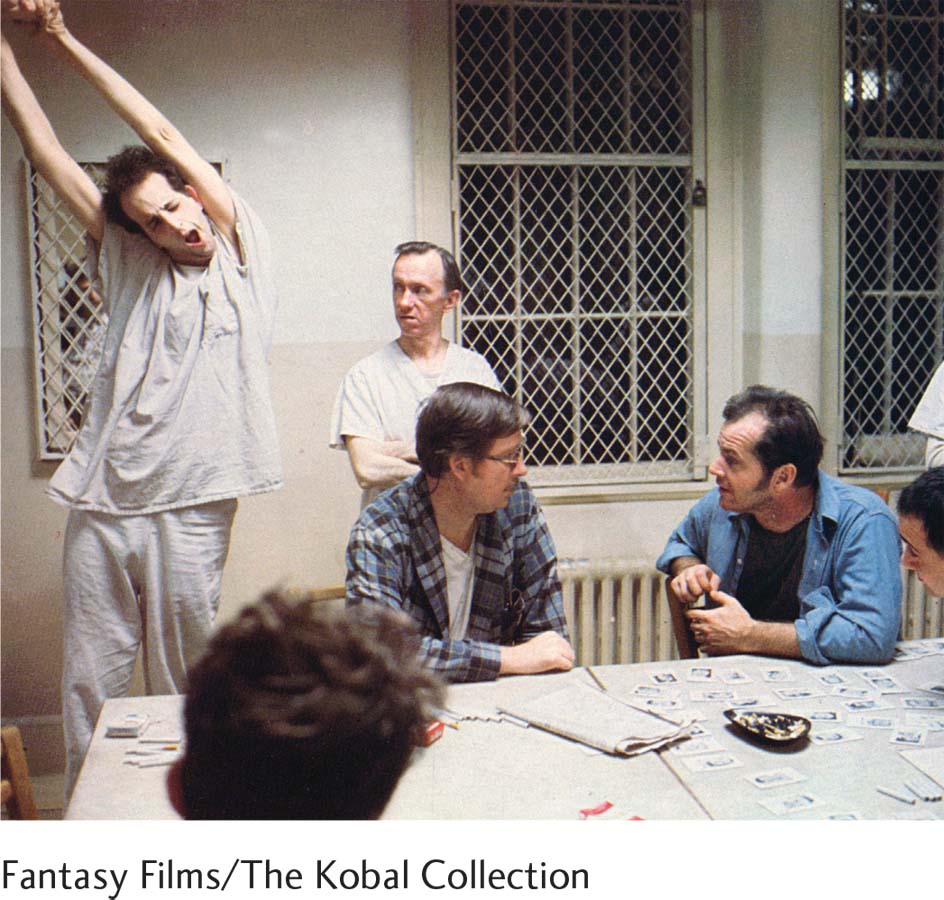
Jack Nicholson (blue shirt) portrays the character R. P. McMurphy in the 1975 classic One Flew Over the Cuckoo’s Nest. In the film, McMurphy fakes the symptoms of a psychological disorder to get admitted into a mental hospital, where he and his fellow inmates are manipulated and abused. Although the movie deviated somewhat from reality, it did raise awareness about the problems with American mental institutions (Goodfriend, 2012, May 22).
No hospital staff member identified the pseudopatients as frauds. If anyone had them figured out, it was the other patients in the hospital. “You’re not crazy,” they would say to the pseudo-
Some critics raised legitimate concerns about the methodology, results, and conclusions of Rosenhan’s study (Lando, 1976; Spitzer, 1975). Nevertheless, it shed light on the persistence of labels and their associated stigma.
CONNECTIONS
In Chapter 10, we discussed the concepts of reliability and validity in relation to the assessment of personality. Here, we refer to these same concepts when discussing a classification system for psychological disorders. We must determine if diagnoses are reliable (able to provide consistent, reproducible results) and valid (measuring what they intend to measure).
If eight sane people could be diagnosed with serious disorders like schizophrenia, you might be wondering if psychological diagnoses are reliable or valid. We’ve come a long way since 1973, but the diagnosis of psychological disorders remains a challenge, in part because it often relies on self-
ATHEORETICAL APPROACH The DSM authors tried to address this problem in 1980, by developing a checklist of observable signs and symptoms. This atheoretical approach removed the emphasis on particular theories and made it easier for mental health professionals to agree on diagnoses. But this method brought its own set of problems. Relying on checklists rather than theory tends to limit clinicians’ understanding of their patients, and the overlapping of criteria across disorders led to some individuals being overdiagnosed (McHugh & Slavney, 2012). Yet, getting the right diagnosis is critical. If one patient is feeling down due to a “life encounter,” such as the loss of a spouse, and another is feeling the same as a result of a “brain disease,” such as bipolar disorder, their treatment needs will be drastically different (McHugh & Slavney, 2012).
“Abnormal,” But Not Uncommon
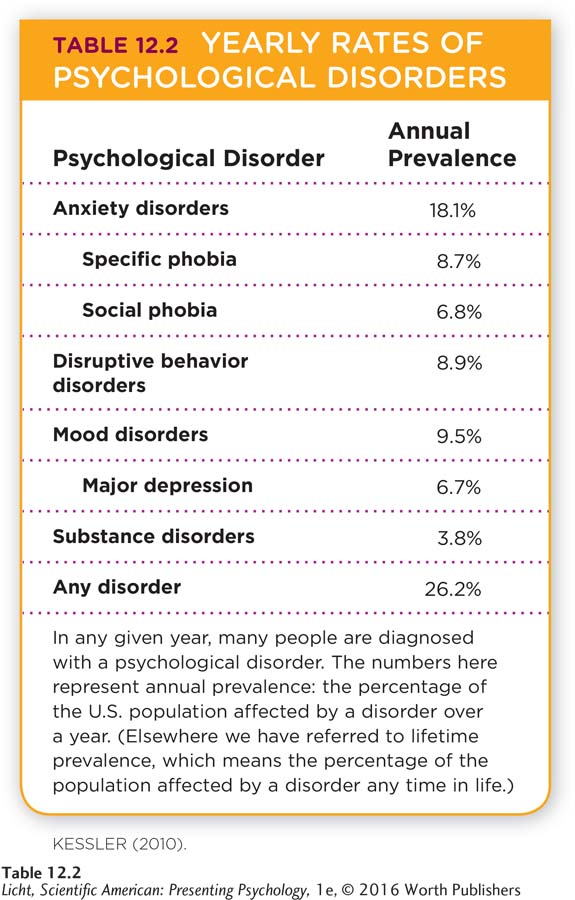
You probably know someone with bipolar disorder, major depressive disorder, or attention-
A TOUGH ROAD With such high rates of disorders, you can be sure there are many people around you dealing with tough issues. In some cases, psychological disorders lead to greater impairment than chronic medical conditions, yet people with mental ailments are less likely to get treatment (Druss et al., 2009). Keep in mind that various psychological disorders are chronic (a person suffers from them continuously), others have a regular pattern (symptoms appear every winter, for example), and some are temporary.

Tripoli, Lebanon, is rocked by explosions in the summer of 2013. Over half of the Lebanese population has witnessed the events of war, and this exposure to violence and death seems to increase the likelihood of developing a psychological disorder (Karam et al., 2008).
comorbidity (kō-'mȯr-
Further complicating the picture is the fact that many people suffer from more than one psychological disorder at a time, a phenomenon called comorbidity (kō-'mȯr-
What Causes Psychological Disorders?
LO 3 Summarize the etiology of psychological disorders.
As we describe psychological disorders throughout this chapter, we will highlight some of the major theories of their etiology, or causal factors. But before getting into the specifics, let’s familiarize ourselves with the models commonly used to explain the causes of psychological disorders.
Synonyms
medical model biological model
medical model An approach suggesting that psychological disorders are illnesses that have underlying biological causes.
IT’S IN YOUR BIOLOGY: THE MEDICAL MODEL The medical model explains psychological disorders from a biological standpoint, focusing on genes, neurochemical imbalances, and problems in the brain. This medical approach has had a long and uninterrupted history, as our culture continues to view psychological disorders as illnesses. It is evident in the language used to discuss disorders and their treatment: mental illness, therapy, remission, symptoms, patients, and doctors. Some scholars criticize this approach (Szasz, 2011), in part because it fails to acknowledge how concepts of mental health and illness have changed over time and across cultures (Kawa & Giordano, 2012).
CONNECTIONS
In Chapter 5, we presented a variety of theories that explain how behaviors are learned. Here, we see how learning theories help us understand the development of abnormal behavior. Previous chapters have also discussed Freud’s psychoanalytic theory, which suggests that early experiences may pave the way for psychological disorders.
IT’S IN YOUR MIND: PSYCHOLOGICAL FACTORS Another way to understand the etiology of disorders is to focus on the contribution of psychological factors. Some theories propose that cognitive factors or personality characteristics contribute to the development and maintenance of disorders. Others focus on the ways learning or childhood experiences might lay their foundation.
IT’S IN YOUR ENVIRONMENT: SOCIOCULTURAL FACTORS Earlier we mentioned that culture can shape definitions of “abnormal” and influence the development of psychological disorders. Social factors, like poverty and community support systems, can also play a role in the development and course of these conditions (Honey, Emerson, & Llewellyn, 2011; Lund et al., 2011).
We have established that mental disorders result from a confluence of biological, psychological, and social factors. But is there a way to bring them together? Complex behaviors deserve complex explanations.
THE BIOPSYCHOSOCIAL PERSPECTIVE As we have suggested in previous chapters, the best way to understand human behavior is to examine it from a variety of perspectives. The biopsychosocial perspective provides an excellent model for explaining psychological disorders, suggesting they result from a complex interaction of biological, psychological, and sociocultural factors (Figure 12.1). For example, some disorders appear to have a genetic basis, but their symptoms may not be evident until social or psychological factors come into play. We will discuss this again in the section on schizophrenia, when we take a look at the diathesis–
CONNECTIONS
We have introduced psychological disorders in various chapters of this book. In Chapter 9, we discussed eating disorders in the context of motivation of hunger, as well as sexual dysfunctions outlined in the DSM–
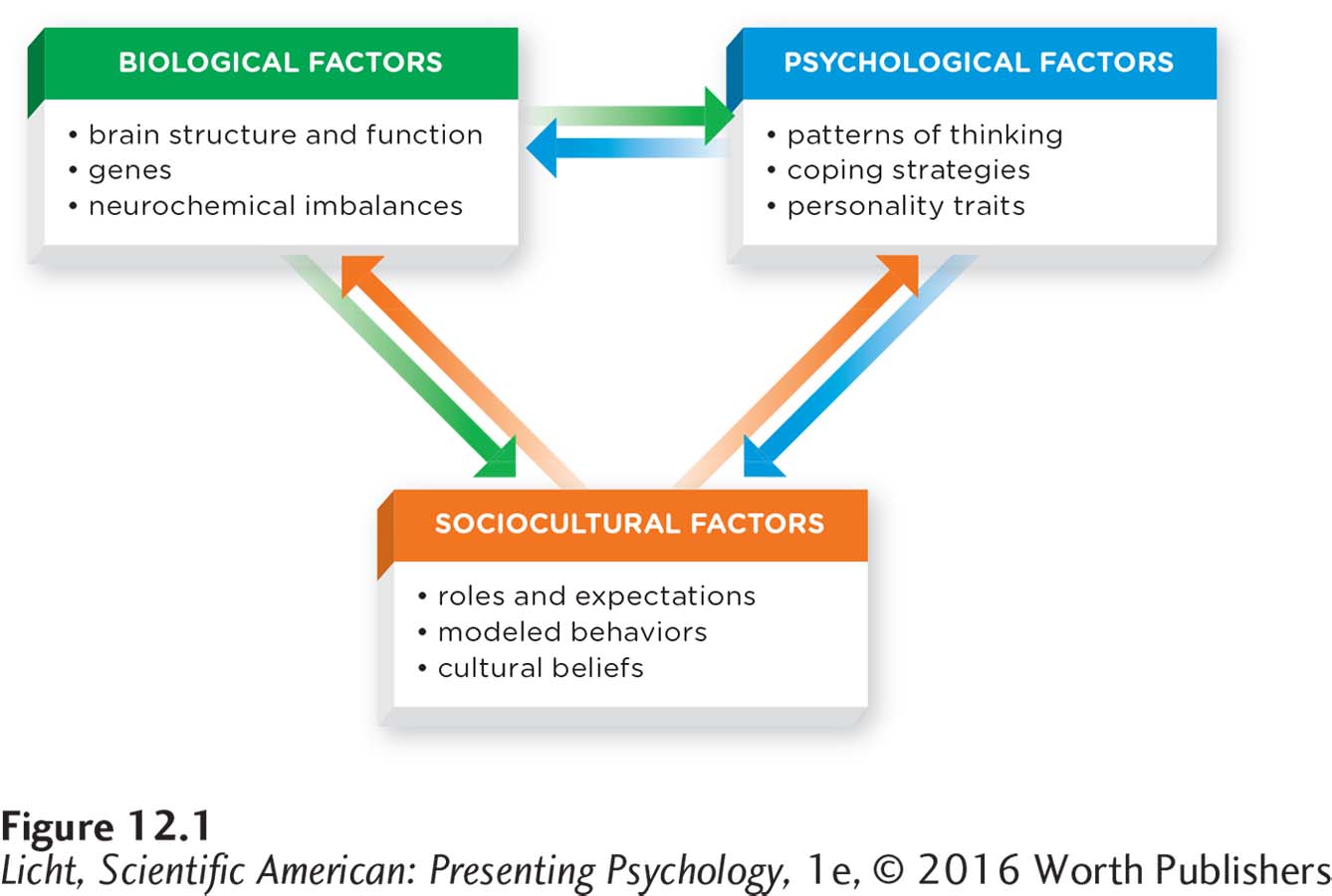
The biopsychosocial perspective considers the complex interaction of biological, psychological, and sociocultural factors that may contribute to a specific disorder.
Now that we have a general understanding of how psychologists conceptualize psychological disorders, let’s delve into specifics. We cannot cover every disorder identified in the DSM–
show what you know
Question 1
1. Which of the following is a criterion used to define abnormal behavior?
dysfunction
psychopathology
developmental processes
stigma
a. dysfunction
Question 2
2. Using Table 12.1 on page 477 as your guide, think of behaviors that are (1) atypical but not dysfunctional; (2) dysfunctional but not distressful; and (3) deviant but not dysfunctional.
Answers will vary (see Table 12.1). An atypical behavior that is not dysfunctional might be an adolescent who dyes his hair in many different shades of green. A dysfunctional behavior that is not distressful might be someone having difficulty getting out of bed in the morning because she stayed up late to meet a deadline for the next day. Deviant but not dysfunctional behaviors were demonstrated in 2011 by the Occupy Wall Street protesters who slept in public places and refused to move when asked to do so by the police during their protests.
Question 3
3. The classification and diagnosis of psychological disorders have been criticized for:
using specific criteria to identify disorders.
the creation of labeling and expectations.
placing too much emphasis on sociocultural factors.
their research base.
b. the creation of labeling and expectations.
Question 4
4. One common approach to explaining the etiology of psychological disorders is the ____________, which suggests that psychological disorders have underlying biological causes, such as genes, neurochemical imbalances, and problems in the brain.
medical model